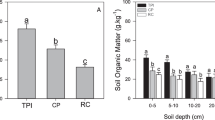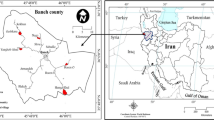Abstract
The aim of the study was to analyse the pedological, chemical and biochemical properties of soil in order to assess the effect of plant cover species (chestnut, Douglas-fir and mixed vegetation) on soil processes. The selected area under Douglas-fir reforestation was homogeneous for climate, morphology and parent material. The study involved three soils: under chestnut forest (CS), Douglas-fir reforestation (DF) and the transition zone (T). A soil profile differentiation occurred after 50 years of Douglas-fir plantation. The thickness of soil horizons at the surface varied, and the OH horizon in T site was fourfold thicker than that in DF site. The A1 mineral horizon in T site was also thicker than that in DF site. The Munsell value of mineral horizons was significantly lower in DF than CS site. Morphological differences (thickness and colour) probably reflect soil organic matter quality changes: in DF higher values of humification index were found in surface layers (OF/OH or OH and A1) and lower in deep organo-mineral and transition horizons (A2 and BA or AB) with respect to CS site. Also, a slight increase of weathering process was observed under Douglas-fir reforestation. The morphological, chemical and biological properties of soil were effective to assess the impact of various vegetation types on soil organic matter properties related to pedogenetic process. The various methodological approaches allow studying soil processes using a small–medium spatial scale sampling scheme.






Similar content being viewed by others
References
Anderson TH, Domsch KH (1989) Ratios of microbial biomass carbon to total organic-C in arable soils. Soil Biol Biochem 21:471–479
Andreux F, Roux F, Linglois N, Nguyen T-K-N, Amiotte Suchet P, Lévêque J (2002) Impact of changing forest management on soil organic matter in low mountain acid media. Dev Soil Sci 28(PART A):383–407
Augusto L, Turpault MP, Ranger J (2000) Impact of forest tree species on feldspar weathering rates. Geoderma 96:215–237
Badalucco L, Gelsomino A, Dell’Orco S, Grego S, Nannipieri P (1992) Biochemical characterization of soil organic compounds extracted by 0.5 M K2SO4 before and after chloroform fumigation. Soil Biol Biochem 24:569–578
Baxter SJ, Oliver MA, Archer JR (2006) The representative soil sampling scheme of England and wales: the spatial variation of topsoil nutrient status and pH between 1971 and 2001. Soil Use Manag 22:383–392
Burt R, Wilson MA, Lee CW (2006) Use of soil survey mapping and sampling for determining geochemistry of regions. Commun Soil Sci Plant Anal 37:2119–2125
Ciavatta C, Govi M, Vittori Antisari L, Sequi P (1990) Characterization of humified compounds by extraction and fractionation on solid polyvynilpyrrolidone. J Chromatog 509:141–146
De Philippis A (1951) Forest ecology and phytoclimatology. FAO, Unasylva 5:1
Degórski M (2003) Local variability of soil properties of forest stands along the north-south climatic transect in Europe. Pol J Ecol 51:461–469
Dell’Abate MT, Benedetti A, Trinchera A, Dazzi C (2002) Humic substances along the profile of two Typic Haploxerert. Geoderma 107:281–296
Dilly O, Munch JC (1998) Ratios between estimates of microbial biomass content and microbial activity in soils. Biol Fertil Soils 27:374–379
Egli M, Fitze P, Mirabella A (2001) Weathering and evolution of soils formed on granitic, glacial deposits: results from chronosequences of Swiss alpine environments. Catena 45:19–47
Egli M, Wernli M, Kneisel C, Haeberli W (2006) Melting glaciers and soil development in the proglacial area Morteratsch (Swiss Alps): I. Soil type chronosequences. Arcti Antarct Alp Res 38:499–509
FAO (2006) Guidelines for soil description, 4th edn. Food and Agriculture Organization of the United Nations, Rome, pp 43–44
Godbold DL, Fritz HW, Jentschke G, Meesenburg H, Rademacher P (2003) Root turnover of Norway spruce (Picea abies) is affected by soil acidity and contributes strongly to forest floor litter. Tree Physiol 23:915–921
Isermeyer H (1952) Eine einfache Methode sur Bestimmung der Bodenatmung und der Karbonate im Boden. Z Pflanzanernah Bodenk 56:26–38
IUSS Working Group WRB (2007) World reference base for soil resources 2006, first update 2007. World Soil Resources Reports, 103. FAO, Rome
Jaffrain J, Gérard F, Meyer M, Ranger J (2007) Assessing the quality of dissolved organic matter in forest soils using ultraviolet absorption spectrophotometry. Soil Sci Soc Am J 71:1851–1858
Kelly EF, Chadwick OA, Hilinski TS (1998) The effect of plants on mineral weathering. Biogeochemistry 42:21–53
Kubartová A, Ranger J, Berthelin J, Beguiristain T (2009) Diversity and decomposing ability of saprophytic fungi from temperate forest litter. Microbial Ecol 58:98–107
Marinari S, Bonifacio E, Moscatelli MC, Falsone G, Vittori Antisari L, Vianello G (2013) Soil development and microbial functional diversity: proposal for a methodological approach. Geoderma 192:437–445
Marshall DD, Curtis RO (2005) Evaluation of silvicultural options for harvesting Douglas-fir young-growth production forests. In: CE Peterson, DA Maguire (Eds) Balancing ecosystem values: innovative experiments for sustainable forestry. Proceedings of a conference. Gen. Tech. Rep. PNW-GTR-635. Portland, OR: U.S. Department of Agriculture, Forest Service, Pacific Northwest Research Station, Portland, OR, pp 119–125
Marx MC, Wood M, Jarvis SC (2001) A microplate fluorimetric assay fir the study of enzyme diversity in soils. Soil Biol Biochem 33:1633–1640
Mehra OP, Jackson ML (1960) Iron oxide removal from soils and clays by a dithionite-citrate system buffered with sodium bicarbonate. Clays and clay minerals. Proceedings of the 7th national conference on clays and clay minerals. Oct. 20–23, 1958, Washington, D.C.
Newhall F (1972) Calculation of soil moisture regimes from the climatic record. Revision 4. USDA Soil Conservation Service, Washington
Nugent MA, Brantley SL, Pantano CG, Maurice PA (1998) The influence of natural mineral coatings on feldspar weathering. Nature 395:588–591
Oliver MA, Archer JR, Baxter SJ, Todd AD, Skinner RJ (2006) The representative soil sampling scheme of England and wales: a statistical analysis of topsoil nutrient status and pH between 1971 and 2001. Soil Use Manag 22:372–382
Page-Dumroese DS, Loewenstein H, Graham RT, Harvey AE (1990) Soil source, seed source, and organic matter content effects on Douglas-fir seedling growth. Soil Sci Soc Am J 54:229–233
Prietzel J, Bachmann S (2012) Changes in soil organic C and N stocks after forest transformation from Norway spruce and Scots pine into Douglas fir, Douglas fir-spruce, or European beech stands at different sites in Southern Germany. Forest Ecol Manag 269:134–148
Rothe A, Binkley D (2001) Nutritional interactions in mixed species forests: a synthesis. Can J Forest Res 31:1855–1870
Rumpel C, Kögel-Knabner L (2011) Deep soil organic matter a key but poorly under stood component of terrestrial C cycle. Plant Soil 338:143–158
Schoeneberger PJ, Wysocki DA, Benham EC, Soil Survey Staff (2012) Field book for describing and sampling soils, version 3.0. Natural Resources Conservation Service, National Soil Survey Center, Lincoln, NE.D
Schwertmann U (1964) Differenzierung der Eisenoxide des Bodens durch Extraktion mit Ammoniumoxalat-lösung. Zeitschrift für Pflanzenernhärung, Düngung und Bodenkunde 105:194–201
Shi A, Penfold C, Marschner P (2013) Decomposition of roots and shoots of perennial grasses and annual barley—separately or in two residue mixes. Bio Fertil Soils 49:673–680
Springer U, Klee J (1954) Prüfung der Leistungsfähigkeit von einigen wichtigeren Verfahren zur Bestimmung des Kohlenstoffs mittels Chromschwefelsäure sowie Vorschlag einer neuen Schnellmethode. Z Pflanzenernährung Bodenk 64:1
Summer ME, Miller WP (1996) Cation exchange capacity and exchange coefficients. In: Sparks DL (ed) Methods of soil analysis, part 3. Chemical methods. Soil Science Society of America and American Society of Agronomy, Madison, pp 1201–1229
Tarrant RF, Miller RE (1963) Accumulation of organic matter and soil nitrogen beneath a plantation of red alder and Douglas-fir. Soil Sci Soc Am J 27:231–234
Tilston EL, Halpin C, Hopkins DW (2013) Decomposition of tobacco roots with modified phenylpropanoid content by fungi with contrasting lignocellulose degradation strategies. Biol Fertil Soils 49:305–311
Trasar-Cepeda C, Leirós MC, Gil-Sotres F (2008) Hydrolytic enzyme activities in agricultural and forest soils. Some implications for their use as indicators of soil quality. Soil Biol Biochem 40:2146–2155
Trum F, Titeux H, Ranger J, Delvaux B (2011) Influence of tree species on carbon and nitrogen transformation patterns in forest floor profiles. Ann For Sci 68:837–847
Valloni R, Zuffa GG (1984) Provenance changes for arenaceous formations of the northern Apennines, Italy. Geol Soc Am Bull 95:1035–1039
Van Reeuwijk LP (2002) Procedures for soil analysis. Technical Paper n. 9. International Soil Reference and Information Centre, Wagningen, 11–1
Van Wambeke AR (2000) The Newhall simulation model for estimating soil moisture & temperature regimes. Department of Crop and Soil Sciences, Cornell University, Ithaca
Vance ED, Brookes PC, Jenkinson DS (1987) An extraction method for measuring soil microbial biomass C. Soil Biol Biochem 19:703–707
Vepsäläinen M, Kukkonen S, Vestberg M, Sirviö H, Niemi RM (2001) Application of soil enzyme activity test kit in a field experiment. Soil Biol Biochem 33:1665–1672
Vittori Antisari L, Dell’Abate MT, Buscaroli A, Gherardi M, Nisini L, Vianello G (2010) Role of soil organic matter characteristics in a pedological survey: “Bosco Frattona” natural reserve (Site of Community Importance, Italy) case study. Geoderma 156:302–315
Vittori Antisari L, Marinari S, Dell’Abate MT, Baffi C, Vianello G (2011) Plant cover and epipedon SOM stability as factors affecting brown soil profile development and microbial activity. Geoderma 161:212–224
Wardle DA, Ghani A (1995) A critique of the microbial quotient (qCO2) as a bioindicator of disturbance and ecosystem development. Soil Biol Biochem 27:1601–1610
Whiteside ID, Wilcox MD, Tustin JR (1977) New Zealand Douglas fir timber quality in relation to silviculture. New Zeal J For 22:24–44
Wittich W (1961) Der Einfluss der Baumart auf den Bodenzustand. Allg Forstzeitschr 16:41–45
Acknowledgments
We thank Enrico Cappelloni commander of the Forest Service of Italian State, Monghidoro District (Northern Italy), and his staff for information and dendrometric measures relating to the survey site.
Author information
Authors and Affiliations
Corresponding author
Rights and permissions
About this article
Cite this article
Falsone, G., Marinari, S., Vittori Antisari, L. et al. Soil processes related to organic matter modifications following Douglas-fir mature reforestation. Biol Fertil Soils 51, 277–287 (2015). https://doi.org/10.1007/s00374-014-0971-2
Received:
Revised:
Accepted:
Published:
Issue Date:
DOI: https://doi.org/10.1007/s00374-014-0971-2




